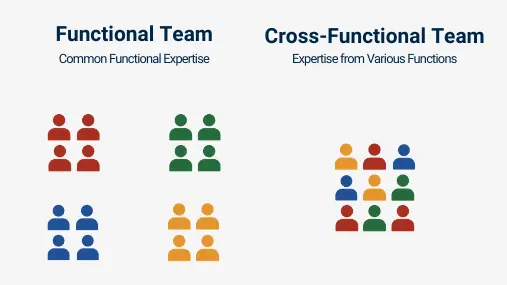What happens if an organization sees the indicators that they are struggling, but after assessing each department and team, sees that the members collaborate, respect their leader, and don’t even face any destructive conflict? Well, maybe the problem isn’t within each team. Perhaps the issues are between them.
This is a problem that happens all too often. Once an organization has established high-performing teams, it's easy to assume that all these high-performing teams will create a high-performing organization. However, this is only the case when the organization also has highly effective cross-functional leaders.
The cross-functional leader has the power to truly drive organizational performance. They have the power to create a link between departments—to be the connector of high-performing teams. And this power can turn high-performing teams into high-performing organizations. So, where does this power come from?
I’ll first tell you where power doesn’t come from, and it doesn’t come from their functional team alone. As stated in the Houston Chronicle, “Information silos, which exist when information isn't shared between departments or divisions, can hamper growth and efficiency in your business. Silos can result in a variety of problems, such as duplication of effort, lack of synergy, and missed opportunities.”
The cross-functional leader is most powerful when they break down information silos to gain a new perspective. Often, leaders focus their time and energy towards communication and collaboration within their vertical, such as with their direct reports or manager. However, leaders must prioritize communication and collaboration with their cross-functional peers who sit beside them. Leaders can gain perspective by understanding the goals, priorities, skills, resources, and perspectives of their peers and the departments they oversee. This is why breaking down departmental silos is not just a “feel-good” initiative; it is a critical piece to driving success across the organization.
Here are a few tips to help increase cross-departmental collaboration:
- Hold a weekly forum for departmental leaders to have open discussion and sharing. This meeting should be positioned as a conversational meeting, not a transactional meeting.
- Ensure teams and departments know the purpose of the other teams and departments—what they do, the value they provide, the outcomes they strive for, and how it impacts yours.
- Ensure your company is set up with messaging systems and platforms to collaboratively share ideas, tasks, and projects across different teams.

The Birkman Colors can help illustrate the importance of cross-functional collaboration very simply. At Birkman, we believe that the best teams and organizations consider four different perspectives: Ideation (Blue), Communication (Green), Implementation (Red), and Analyzing (Yellow).
If each of these colors represented a team, each would have a very specific goal, perspective, and way of doing things. Now, imagine if these teams didn’t collaborate, some teams would be implementing at the expense of planning , and others would be analyzing without knowing what to communicate. The Reds would work with the Reds, Greens with Greens, Yellows with Yellows, and Blues with Blues—and each would be limited to the strengths and limitations of their color alone. This same thing happens in organizations. Suppose the Sales, Accounting, Product Development, and Engineering leaders only stick to their functional teams. In that case, each one will be limited to their own goals and perspectives and miss how each of these perspectives comes together to create results for the entire organization. They may achieve their team’s goals, but it will likely be at the expense of organizational outcomes. This is why it’s important to have cross-functional leaders bridge the gap and share information across teams.
It’s human nature to think your power in an organization is in the vertical. But the truth is, authority is in the vertical. Power comes from wherever you can gain a greater perspective, leverage new insights, or increase knowledge. And this typically happens when leaders intentionally collaborate and put energy into working with their cross-functional peers. If you are only collaborating within your team, you are not gaining nearly as much information as you should be.
Next time you assess the effectiveness of the teams at your organization, don’t forget to ask how all of these teams are working together. And next time you ask about collaboration, don’t ask people if they’re collaborating; ask with whom?
Shift from seeing collaboration as within function to across function.
Think not IF I am collaborating, but WHOM am I collaborating with?
How to effectively lead cross-functionally:
Become more effective at managing the business, leading cross-functional teams or projects, and influencing others without authority with Birkman. Our tool helps solve these challenges and be successful in their complex roles. Create an environment for risk-taking and performance, clarity for alignment and execution, share power for mutual benefit, and influence relationships for results.

